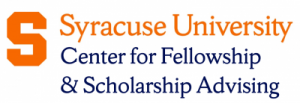Q and A with Emily Malina ’16, 2019-2020 Fulbright U.S. Student Program Alum
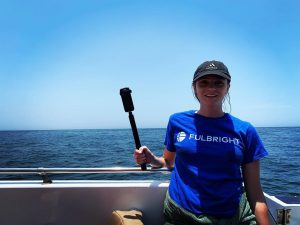
Emily preparing to film underwater in Peru
Emily Malina, a 2016 graduate of the international relations program in The College of Arts and Sciences – Maxwell School and public relations program in the S.I. Newhouse School of Public Communications, received a 2019-2020 Fulbright U.S. Student Program Creative Arts grant to Bolivia and Peru to pursue a film-making project. Emily’s project was to document the stories of the Urus communities in Bolivia and Peru and create a virtual reality documentary.
Although Emily’s Fulbright experience was unfortunately cut short in March 2020 due to Covid-19, Emily spent five months working on her project and getting to better know the culture and people of these two countries. You can read her Q and A with CFSA below!
If you are a Syracuse University student or alum (who is not currently enrolled at another college or university) and would like to apply for the Fulbright U.S. Student program, please start an application on the Fulbright U.S. Student website by June 1st and select “Syracuse University” as the institution through which you would like to apply under the “Award Information” tab.
Q and A with Emily Malina '16, 2019-2020 Fulbright U.S. Student Program Alum
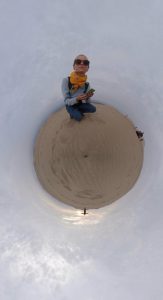
Emily experimenting with her 360 degree filmmaking technology
Why did you choose to apply for a Fulbright Creative Arts grant to Bolivia and Peru?
A professor once said to me that Fulbright invests in your ideas and growth, and to me this really feels true. After I graduated in 2016, I began working full-time [as a communications and design specialist for a nonprofit in DC] and realized that I was not fulfilled by how I spent my time. Applying for a Fulbright Creative Arts grant was a chance to use pieces of my past experience and do a complete 180 with my life. I wanted to pursue film, as well as help tell stories that inspire me. These goals manifested in my project, which was a virtual reality documentary about water rights in South America — stories that connect with those in the United States.
What do you think in your previous experiences helped prepare you for this one?
Everything! Since my project falls under “visual anthropology” — all my classes in Maxwell and Newhouse helped prepare me for this experience. Everything from Tom Perreault’s “Political Ecologies in South America” class to Larry Elin’s “Multimedia Storytelling” helped prepare me for my project. My work experience at NDI and the World Wildlife Fund offered a space for me to use and improve the technical skills I learned at SU in tangible ways.
Although I won this grant three years after graduating, I had a lot of support from my professors, advisors and mentors from SU. Their advice was also essential to my preparation. Each person offered hours of their time to speak with me about my application, write recommendations and many helped me frequently while I was in Peru.
What was your project?
I was creating a virtual reality documentary on the socio-cultural impact of resource extraction and climate change in Peru. In particular, I focused on the impacts to communities around freshwater systems (like lakes, rivers). My ultimate project goal is to foster mutual understanding, consciousness, and empathy — kind of like the saying “walk a mile in someone else’s shoes.” Virtual reality is an excellent tool to create that sensation, as if someone was transported into a different space.
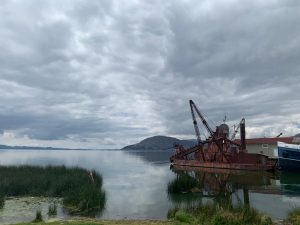
Lake Titicaca in Puno, Peru. This would have been Emily's filming location had her grant not been disrupted by concerns over Covid-19.
My plan was to film communities along Lake Titicaca in Peru, as well as some communities in Bolivia — and later connect them back to stories in the U.S.
What did a typical day look like for you?
Since my project was split into two parts, anthropology and filming, I split my time that way. About three days a week I worked on camera practice and learn new techniques. The rest of the days, I did research by reading studies and watching other documentaries! I also set up meetings with people who do similar work (either film, anthropology, environmental justice) in Peru.
Having a balance is important to me, so I also made time to go to yoga and cook. I also joined a theater club to have a creative outlet and make new friends!
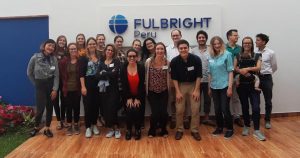
Emily's 2019-2020 Fulbright Peru cohort
What was the most surprising part of your experience?
Before I left the US, a lot of past research/creative arts Fulbrighters told me it would be a “transformative” experience. It sounds cliché, but it’s true. You’re in the country to work on your project, but in order to do so each person is pushed to use their strengths and confront their weaknesses to achieve the project outcomes. In doing so, you grow exponentially, meet incredible people, and make countless memories.
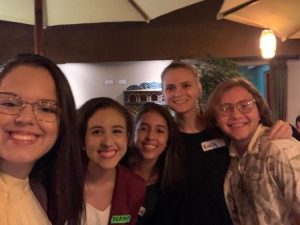
Emily at "La La," a youth development seminar at which she presented her research on film and conservation
What do you wish you knew before you arrived?
The first couple of months are the most difficult. It’s really important to allow yourself the space to find footing before diving into the project. Also, specifically for my project I wish I had known that experimenting and taking risks is part of the process! Once you get in-country, it’s important to break down what you think you know from what IS. Experimenting and adapting my project was necessary to tell stories in the most authentic way possible.
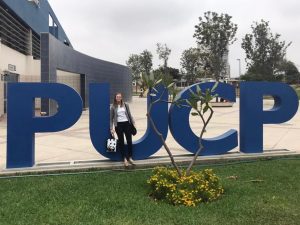
Emily at La Universidad Católica de Peru, her affiliate in Peru
What role did the Center for Fellowship and Scholarship Advising (CFSA) play in your application?
I definitely couldn’t have done this application (twice!) without the help of CFSA — especially as an alum. Jolynn helped me prepare my Fulbright-National Geographic application last year (I was a semi-finalist), as well as this year for a Creative Arts grant. It’s crucial to have someone who knows the process to look over your drafts, and in my case Jolynn also looked over my creative portfolio. It’s nice to know that CSFA provides that support to not just current students but those of us who are a few years out!
Is there a way for someone interested in your work to follow your project and future work?
I have a professional Instagram account: @emily.malina! I often posted project updates and lessons I learned while in Peru. You can find a link to my video blogs (vlogs!) on there a well.
Thank you, Emily, for sharing your experience with the CFSA Community!
